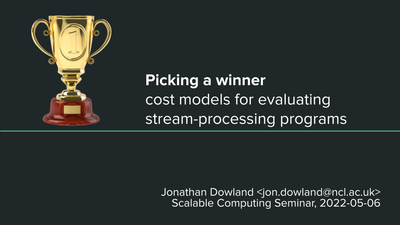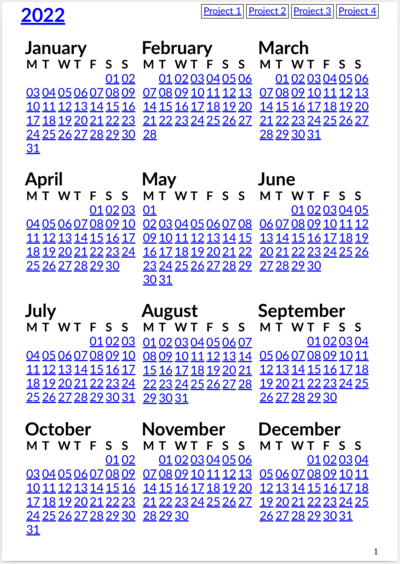jmtd → Jonathan Dowland's Weblog
Below are the five most recent posts in my weblog. You can also see a chronological list of all posts, dating back to 1999.
Last week I delivered a seminar for the research group I belong to, Scalable Computing. This was a slightly-expanded version of the presentation I gave at uksystems21. The most substantial change is the addition of a fourth example to describe recent work on optimising for a second non-functional requirement: Bandwidth.
- scalable seminar 2022.pdf (PDF, 474K)
I've been having reasonable success with time blocking, a technique I learned from Cal Newport's writings, in particular Deep Work. I'd been doing it on paper for a while, but I wanted to try and move to a digital solution.
There's a cottage industry of people making (and selling) various types of diary and planner as PDF files for use on tablets such as the Remarkable. Some of these use PDF hyperlinks to greatly improve navigating around. This one from Clou Media is particularly good, but I found that I wanted something slightly different from what I could find out there, so I decided to build my own.
I explored a couple of different approaches for how to do this. One was Latex, and here's one example of a latex-based planner, but I decided against as I spend too much time wrestling with it for my PhD work already.
Another approach might have been Pandoc, but as far as I could tell its PDF pipeline went via Latex, so I thought I might as well cut out the middleman.
Eventually I stumbled across tools to build PDFs from HTML, via "CSS Paged Media". This appealed, because I've done plenty of HTML generation. print-css.rocks is a fantastic resource to explore the print-specific CSS features. Weasyprint is a fantastic open source tool to convert appropriately-written HTML/CSS into PDF.
Finally I wanted to use a templating system to take shortcuts on writing HTML. I settled for embedded Ruby, which is something I haven't touched in over a decade. This was a relatively simple project and I found it surprisingly fun.
The results are available on GitHub: https://github.com/jmtd/planner. Right now, you get exactly what I have described. But my next plan is to add support for re-generating a planner, incorporating new information: pulling diary info from iCal, and any annotations made (such as with the Remarkable tablet) on top of the last generation and preserving them on the next.
My first self-designed functional 3D print is a replacement battery cover for a LED fake-candle that my daughter uses as a night-light.
I measured the original cover (we have three of the candles) using a newly-purchased micrometer and tried to re-create it in OpenSCAD. I skipped the screw-hole that is for securing the cover as we don't use that.
I sliced it using Cura and printed it using PETG on our office 3D printer, a Ender 3. Print time was about an hour.
To my amazement, my first take fits snugly!
I've uploaded the OpenSCAD source here: batterycover.scad. It's covered under the terms of Creative Commons Attribution-ShareAlike 4.0 International (CC BY-SA 4.0).
This year I've decided to bite the bullet and properly try out hledger for personal accounting. It seems I need to commit to it properly if I'm to figure out whether it will work for me or not.
Up until now I'd been strictly separating my finances into two buckets: family and personal. I'd been using GNUCash for a couple of years for my personal finances, initially to evaluate it for use for the family, but I had not managed to adopt it for that.
I set up a new git repository to track the ledger file, as well as a
notes.txt "diary" that documents my planning around its structure and how to
use it, and a import.txt which documents what account data I have imported
and confirmed that the resulting balances match those reported on monthly
statements.
For this evaluation, I decided to bite the bullet and track both family and
personal finances at the same time. I'm still keeping them conceptually very
separate. To reflect that I've organised my account names around that: all
accounts relating to family are prefixed family:, and likewise personal
jon:.1 Some example accounts:
family:assets:shared - shared bank account
family:dues:jon - I owe to family
family:expenses:cat - budget category for the cat
income - where money enters this universe
jon:assets:current - my personal account
jon:dues:peter - money Peter owes me
jon:expenses:snacks - budget category for coffees etc
jon:liabilities:amex - a personal credit card
I decided to make the calendar year a strict cut-over point: my personal
opening balances in hledger are determined by what GNUCash reports. It's
possible those will change over this year, as adjustments are made to last
year's data: but it's easy enough to go in and update the opening balances
in hledger to reflect that.
Credit cards are a small exception. January's credit card bills are paid in
January but cover transactions from mid-December. I import those transactions
into hledger to balance the credit card payment. As a consequence, the "spend
per month" view of my data is a bit skewed: All the transactions in December
should be thought of as in January since that's when they were paid. I need to
explore options to fix this.
When I had family and personal managed separately, occasionally something
would be paid for on the wrong card and end up in the wrong data. The solution
I used last year was to keep an account dues:family to which I posted those
and periodically I'd settle it with a real-world bank transfer.
I've realised that this doesn't work so well when I manage both together: I can't track both dues and expense categorisation with just one posting. The solution I'm using for now is hledger's unbalanced virtual postings: a third posting for the transaction to the budget category, which is not balanced, e.g.:
2022-01-02 ZTL*RELISH
family:liabilities:creditcard £ -3.00
family:dues:jon £ 3.00
(jon:expenses:snacks) £ 3.00
This works, but it completely side-steps double-entry book keeping, which is the whole point of using a double-entry system. There's also no check and balance that the figure I put in the virtual posting (£3) matches the figure in the rest of the transaction. I'm therefore open to other ideas.
-
there are a couple of places in
hledgerwhere default account names are used, such as the default place that expenses are posted to during CSV imports:expenses:unknown, that obviously don't fit myfamily/jon:prefix scheme. The solution is to make sure I specify a default posting-to account in all my CSV import rules.↩
Brian Eno's classic 1975 album Another Green World, with the iconic cover crop from Tom Philip's After Raphael. This is a recent pressing. I try to avoid buying new vinyl, and I think I got this as part of a trade-in swap two years ago when I went to get one of my first Covid vaccinations in Newcastle. It was the first time I'd been anywhere near a record shop (which was adjacent to the temporary vaccine centre) in a year or more, and I took the opportunity to bring in some records to sell. I definitely left with fewer records than I went in with, at least…
What to say about this album? It's a classic, it's weirdly compelling, it dances over the line between engaging your attention and something you can have on in the background. Many of the tracks are quite short relative to the ideas they express: I imagine some remixer could have a lot of fun with it. The Big Ship is perhaps the standout, but I really like the title track, and opener Sky Saw too.
It's probably the first album written using using the oblique strategies card system.
Older posts are available on the all posts page.







Comments